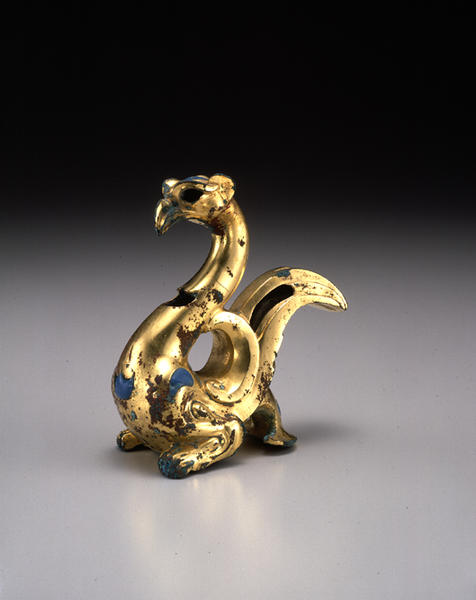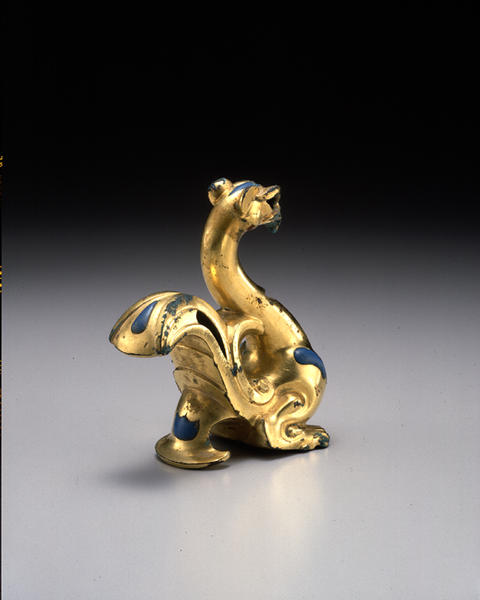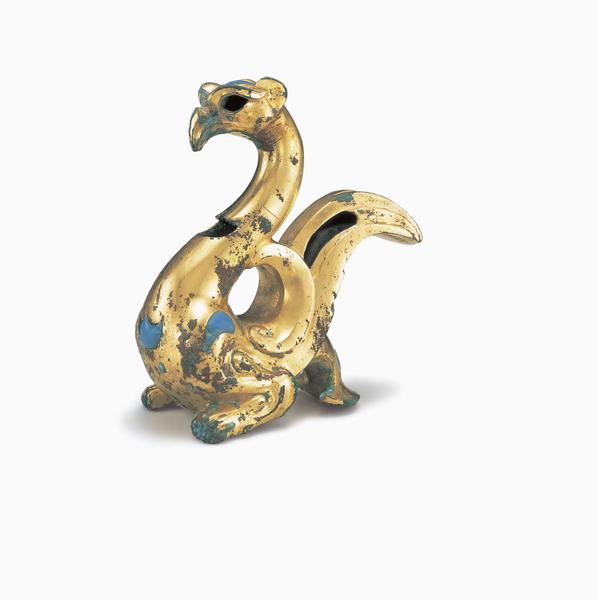鳳凰形装飾
- 中国
- 中国・前漢時代
- 紀元前3世紀-1世紀
- 鍍金青銅、ガラス
- H-10.2 D-9 W-4.9
解説(開館1周年記念展)
この青銅鍍金の動物は嘴の先から頭部,首を通って胸部胴部へとS字形の線を描き,背中から生えた翼が前方に反り返って首後部から背中にかけての線とともに輪を作る。尾羽は胴体後部から立ち上がり,もう一つのS字形の流れを作っている。脚は翼よりも前方に付き,猛獣に見られる爪先が鋭く筋肉張った力強い獣脚を造り出し,尾羽の基部から扇形に広がる補助的な脚が下に付いている。頭頂部,胸部,獣脚の付け根,尾羽後方,扇形の脚に緑青色のガラスが象嵌され,眼窩,首部と尾羽側面はかつての象嵌が失われたものと思われ,穴になっている。
この一見,中国の伝統的な青銅器の蓋に見られる鳳凰形を思わせる動物は,鳳凰の頭部と猛獣の脚部,象徴的な小翼をもち,ユーラシアステップ由来の,猛禽の頭部と猛獣の体躯をもったグリフィンに通じる要素がある。戦国時代に北方の遊牧民族を通じてもたらされた外来要素は,文学的には瑞兆を示す動物として導入され中国化されていったが,工芸の世界ではこの遊牧民族との交渉を通じ,中国の職人が帯鉤をはじめとする装身具を製作してきた過程で,それまで中国では知られていなかった要素を学んでいったのである。
同時代の類例としてカロン・ダ・コレクションの円形装飾牌に見られる,猛禽頭部,猛獣体躯で偶蹄類の前脚をもった動物,*1 P. ウルドリー・コレクションの猛獣の脚をもった,いくぶん様式化された猛禽形の装飾が挙げられる。*2 特に後者は頭部から体躯尾羽に至る線のながれが酷似している。
蝋型で鋳造され,首の左脇,右顔面,尾羽裏側に中子押さえの矩形の痕が見られる。腹部に何かに取り付けるためのものと思われる矩形の穴が見られ,下腹部には文字の陰刻があり「公」と読める〈挿図1〉。
1 J. F. So & E. C. Bunker/Traders and Raiders on China's Northern Frontier/Washington D.C. 1995 no.82
2 Rietberg Museum & P. Uldry/Chinesisches Gold und Silber/Zurich 1994 no.79
Catalogue Entry
This gilt bronze animal is created in an S-curved shape from the tip of the beak to the chest and body, through its head and neck. It also has a loop formed by the contour of its back and curling wings. The tail, extending from the abdomen, creates another S-curve. Its legs, extending from the front of the body back under the wings, suggest a strong, muscular beast's hind legs with sharp claws. At the root of the tail, a fan-shaped supporting leg is attached. Pieces of greenish blue glass are inlaid at the top of the head, chest, shoulders and fan-shaped leg. At the eyeholes, neck, and both sides of the tail, there are empty holes, probably once similarly inlaid.
This animal, reminiscent of ornaments in the shape of a phoenix on the lids of traditional Chinese bronze vessels, has the head of a phoenix, a beast's hind legs and symbolic small wings. Some elements are similar to features of the mythical griffin of the Eurasian steppes, which has the head of a vulture and the body of a beast. Foreign mythical creatures imported by way of the Northern Nomads during the Warring States period were adopted into literary Chinese traditions as auspicious signs. Chinese artisans, on the other hand, learned the foreign elements, which had been unknown till then, through manufacturing ornaments such as belt hooks for the northern tribes in the process of trading with them.
Contemporary examples similar to this piece can be seen in the Calon da Collection, a roundel including a vulture-headed creature with beast's body and forefeet with hoofs;*1 and also in the P. Uldry collection, a stylized vulture-shaped ornament with a beast's hind legs.*2 The line of the latter, from its head to the tail through the body, is similar to the line of this piece.
This piece was cast in the lost-wax method, and some rectangular chaplets are found at the left side of the neck, the right side of the face and the back of the tail. At the bottom of the body, there is a rectangular hole, which is thought to have served for attaching the piece to something else. On the bottom of the supporting foot, a Chinese character has been incised which can be read as 'gong' (fig. 1).
Catalogue Entry
This half-bird, half-animal shape resembles a phoenix at first glance and is a design frequently seen in northern China and among neighboring nomadic peoples. It is thought to have originated in depictions of griffins on the Eurasian Steppes. The body of the form is inlaid in seven places with blue glass thought to imitate turquoise stones, and this recalls the use of glass inlay to imitate turquoise seen in the decorative metel plaques made by the nomadic tribes of the Caucasus and Southern Siberia from this period. This is thought to have been created by a Chinese artisan who had been influenced by the northern nomadic cultures.


